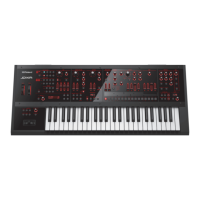5
Tone Edit
1. Press a ANALOG PART Select [01]–[04] button to make it light.
You can select multiple parts by pressing multiple buttons simultaneously.
You can’t select analog parts and digital parts simultaneously.
Each analog part consists of two oscillators.
While editing, you can switch parts or change to selecting multiple parts.
& For details of the overall structure, refer to the “JD-XA Structure Diagram” inside the front cover of the Owner’s Manual.
2. Press the [Menu] button.
3. Use the cursor [
K
] [
J
] buttons to select “TONE EDIT” and press the [Enter] button.
TONE COMMON: Porta Sw parameter appears.
Menu
[Shift] + Cursor [
K
] [
J
]
Parameter
Cursor [
K
] [
J
]
Value
Value [-] [+]
Explanation
TONE COMMON
(Tone Common)
Porta Sw
(Portamento Switch)
OFF, ON Species whether the portamento eect will be applied (ON) or not (OFF).
Porta Time
(Portamento Time)
0–127
When portamento is used, this species the time over which the pitch will change. Higher
settings will cause the pitch change to the next note to take more time.
Legato Sw
(Legato Switch)
OFF, ON
Applies legato. The term “legato” refers to a playing style in which notes are smoothly
connected to create a owing feel. This creates a smooth transition between notes, which is
eective when you wish to simulate the hammering-on and pulling-o techniques used by a
guitarist.
* This is available only if poly stack is “o.”
Unison Sw
(Unison Switch)
OFF, ON
This layers a single sound. If the Unison Switch is on, the number of notes layered on one key
will change according to the number of keys you play.
* This is available only if poly stack is “on.”
Oct Shift
(Octave Shift)
-3–0–+3 Species the octave of the tone.
Bend Range D
(Pitch Bend Range Down)
0–-24
Species the amount of pitch change that occurs when the pitch bend/modulation lever is
moved all the way to the left.
Bend Range U
(Pitch Bend Range Up)
0–+24
Species the amount of pitch change that occurs when the pitch bend/modulation lever is
moved all the way to the right.
Bend Mode
(Pitch Bend Mode)
NORMAL The pitch bend lever works in the conventional way.
C+L
(CATCH+LAST)
The pitch lever aects only the last-sounded note. If you play a note while the pitch bend lever
is already moved, that note sounds at its normal pitch (as though the lever were in the center).
The pitch starts changing only after the lever passes through the center position.
MATRIX CTRL1
(Matrix Control 1)
MATRIX CTRL2
(Matrix Control 2)
MATRIX CTRL3
(Matrix Control 3)
MATRIX CTRL4
(Matrix Control 4)
Src
(Source)
Sets the MIDI message used to change the parameter with the Matrix Control.
Ordinarily, if you wanted to change analogue part parameters using an external MIDI device, you would need to send
System Exclusive messages–MIDI messages designed exclusively for the JD-XA.
However, System Exclusive messages tend to be complicated, and the amount of data that needs to be transmitted can
get quite large.
For that reason, a number of the more typical of the JD-XA’s analog part parameters have been designed so they accept
the use of Control Change (or other) MIDI messages for the purpose of making changes in their values. This provides you
with a variety of means of changing the way tones are played. For example, you can use the Pitch Bend lever to change
the LFO cycle rate, or use the keyboard’s touch to open and close a lter.
The function which allows you use MIDI messages to make these changes in realtime to the tone parameters is called the
“Matrix Control.”
Up to four Matrix Controls can be used in a single part.
To use the Matrix Control, specify which MIDI message (Source) will be used to control which parameter (Dest) and how
greatly (Sens).
* Velocity and Keyfollow correspond to Note messages.
* If you want to use common controllers for the entire JD-XA, select “SYS1”–“SYS4.” MIDI messages used as System
Control 1–4 are set with the Tone Control 1–4 Src (Owner’s Manual “Overall Settings for the JD-XA” (p. 12)
0
“CONTROL”
0
“Sys Ctrl1–4”).
OFF Matrix Control will not be used.
CC01–CC31
CC33–CC95
Controller number 1–31, 33–95
BEND Pitch Bend
AFT Aftertouch
SYS1–SYS4 MIDI messages used as common matrix controls.
VELOCITY Velocity (pressure you press a key with)
KEYFOLLOW Keyfollow (keyboard position with C4 as 0)
TEMPO Tempo specied by the tempo assign source, or the tempo of an external MIDI sequencer
Analog Part

